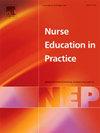Effectiveness of debriefing after a short training on brief tobacco intervention for nursing students: A randomized clinical trial
IF 3.3
3区 医学
Q1 NURSING
引用次数: 0
Abstract
Aim
To determine the effectiveness of debriefing after the objective assessment of brief tobacco interventions (BTI) training and its changes after 3 and 9 months.
Design
Controlled clinical trial with random assignment by blocks.
Methods
145 sec-year students enrolled in a 4-year nursing degree program participated in the study, with 80 in the intervention group and 65 in the control group. Training according to the 5As (Ask, Advise, Assess, Assist and Arrange) and 5Rs (Relevance, Risks, Rewards, Roadblocks and Repetition) model was provided to both the control and experimental groups as a brief tobacco intervention strategy in primary care. Presentation of three clinical scenarios through videotaped objective structured clinical examination (VOSCE) and assessment with the BTI-St© tool. Posterior debriefing with the experimental group. Descriptive statistical analyses, 2-factor repeated measures ANOVA. Each subject was measured 5 times. (ID protocol: NCT06564766)
Results
The time*group interaction results demonstrated significant differences with large effect sizes across all three scenarios. In the experimental groups, the most notable differences were observed immediately after the debriefing compared with baseline. Although these differences decreased over time, they remained present at 3 and 9 months in all scenarios relative to the baseline.
Conclusions
The inclusion of debriefing in a brief intervention for learning about BTI within the context of primary care of nursing students resulted in a significant increase in their learning and greater durability, at least after nine months.
护生短期烟草干预培训后述职的有效性:一项随机临床试验
目的探讨短期烟草干预(BTI)培训客观评估后述职汇报的有效性及其在3个月和9个月后的变化。设计对照临床试验,随机分组。方法145名 四年制护理专业大二学生参与研究,其中干预组80人,对照组65人。根据5As(询问、建议、评估、协助和安排)和5Rs(相关性、风险、奖励、障碍和重复)模型对对照组和实验组进行培训,作为初级保健中的简短烟草干预策略。通过录像客观结构化临床检查(VOSCE)和BTI-St©工具评估三种临床情景。实验组的后向述情。描述性统计分析,双因素重复测量方差分析。每位受试者测量5次。(ID协议:NCT06564766)结果时间*组交互结果在所有三种情况下均显示出显著差异,且效应量较大。在实验组中,与基线相比,最显著的差异是在汇报后立即观察到的。尽管这些差异随着时间的推移而减少,但相对于基线,在所有情况下,它们在3个月和9个月时仍然存在。结论在初级护理的背景下,在一个简短的干预中纳入述职,可以显著提高护生的学习能力和持久性,至少在9个月后。
本文章由计算机程序翻译,如有差异,请以英文原文为准。
求助全文
约1分钟内获得全文
求助全文
来源期刊

Nurse Education in Practice
NURSING-
CiteScore
5.40
自引率
9.40%
发文量
180
审稿时长
51 days
期刊介绍:
Nurse Education in Practice enables lecturers and practitioners to both share and disseminate evidence that demonstrates the actual practice of education as it is experienced in the realities of their respective work environments. It is supportive of new authors and will be at the forefront in publishing individual and collaborative papers that demonstrate the link between education and practice.
 求助内容:
求助内容: 应助结果提醒方式:
应助结果提醒方式:


